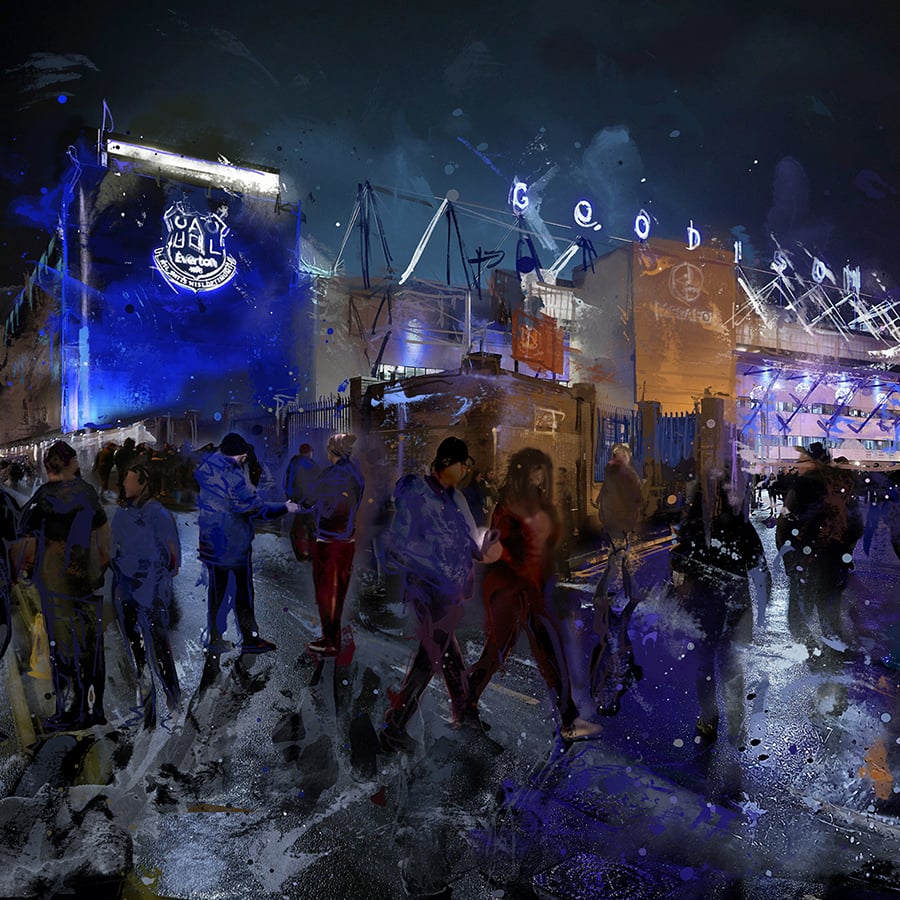
Install the app
How to install the app on iOS
Follow along with the video below to see how to install our site as a web app on your home screen.

Note: this_feature_currently_requires_accessing_site_using_safari
You are using an out of date browser. It may not display this or other websites correctly.
You should upgrade or use an alternative browser.
You should upgrade or use an alternative browser.
I was taking the piss mate.Out of interest, why would you expect us to have a bigger stadium than Spurs?
They have a bigger worldwide fan base than us and are much better positioned geographically to fill their stadium.
No point building a stadium too big that we wouldn't fill.
It looks like a heat sink from an eighties mainframe .View attachment 122870
Architecturally, it'd probably be perceived as an iconic and high-quality design that merges in with the culture of London and the local area.
But for me, it doesn't look like a stadium.
The binman chronicles
Player Valuation: £80m
Yoy have demnad for 60-65k for example, and then fit that into 52/53k. It allows you to push prices up say 30% quite easily.
This is the salient
 point often missed. The club know demand will outstrip supply and therefore gives them ammo to charge more. Don't get me wrong I think we'll still be very reasonably priced compared to most, but it will force people who can afford a couple of hundred a game into the premium areas and if that demand stays high you could then see the club then looking to raise prices to remove the cheaper seat options.
point often missed. The club know demand will outstrip supply and therefore gives them ammo to charge more. Don't get me wrong I think we'll still be very reasonably priced compared to most, but it will force people who can afford a couple of hundred a game into the premium areas and if that demand stays high you could then see the club then looking to raise prices to remove the cheaper seat options.View attachment 122870
Architecturally, it'd probably be perceived as an iconic and high-quality design that merges in with the culture of London and the local area.
But for me, it doesn't look like a stadium.
Isn't that the point?
Just a few points re. the last 10 pages or so. I base this on nothing other than a hunch, but I suspect the capacity when we open for business will be a few thousand more than the 52,000 suggested in the planning docs. Moreover, the increase in capacity to around the 60,000 mark will happen within a few years of opening (again based on nothing other than a hunch) and it will be down to the club having been shrewd enough to take a gamble on rail seating allowing a higher than1:1 ratio at some point in the near future and having therefore overengineered the entrances, exits, concourse and facilities in one part or possibly more of the ground to facilitate this increase. Ultimately, we will have a 60,000 capacity stadium for the price of a 50,000 seater (and for half the cost of Spurs', by the way). Moshiri is no mug.
Regarding the pricing I pay about £550 for the top balcony. I would expect to be paying about £200 more for the same kind of seat and to be honest would not have any issue with that. I expect to spend a good few bob inside the stadium confines each home game, primality on beer. I currently spend nothing at all inside Goodison. One of the good things about the stadium is that due to its location is if they try and rip me off with overpriced rubbish beer I'll drink in town (as I do now) and just turn up 5 minutes before the kick off same as currently. God forbid but if we'd have moved to Kirkby they would have had us by the short and curlies and you would have had to have paid for whatever overpriced rubbish they wanted to sell you. The massive increase in match day revenue will be down to booze and snacks, not from the prawn sandwich brigade. All of the above my own opinion and guesswork, of course.
Regarding the pricing I pay about £550 for the top balcony. I would expect to be paying about £200 more for the same kind of seat and to be honest would not have any issue with that. I expect to spend a good few bob inside the stadium confines each home game, primality on beer. I currently spend nothing at all inside Goodison. One of the good things about the stadium is that due to its location is if they try and rip me off with overpriced rubbish beer I'll drink in town (as I do now) and just turn up 5 minutes before the kick off same as currently. God forbid but if we'd have moved to Kirkby they would have had us by the short and curlies and you would have had to have paid for whatever overpriced rubbish they wanted to sell you. The massive increase in match day revenue will be down to booze and snacks, not from the prawn sandwich brigade. All of the above my own opinion and guesswork, of course.
Last edited:
Lapeno77
Player Valuation: £25m
Looks like a backdrop for a 70s Pink Floyd gig.View attachment 122870
Architecturally, it'd probably be perceived as an iconic and high-quality design that merges in with the culture of London and the local area.
But for me, it doesn't look like a stadium.
Aye, yes you're right, but I was trying to make the point, perhaps not particularly well, that it doesn't look or feel like a stadium should do.Isn't that the point?
The best stadiums have something about them: they're almost imposing to fans and stand out. From the pictures, that monstrosity doesn't give that aura.
It stands out in some senses but on the other hand it blends in and disguises itself which for me stadiums shouldn't do - you don't want to blend in.
Stephen Gibson
Player Valuation: £15m
Am i right in thinking that once the dock is drained we are doing conservation work, protecting it & then filling it back up with sand rather than just drain & fill?Obviously before building begins we need to drain and infill the dock.
This is a process that I expected would take 6 months or more, so I was pleasantly surprised to read this about the construction of the water treatment and sewage plant.
Sand infill
Before construction could begin, 31,000m3 of silt was removed from the base of the Victorian dock. This was undertaken by WD Mersey, a trailing suction hopper dredger operated by Westminster Dredging. Once the silt removal had been completed the dock gates were closed and a concrete filled sheet pile cofferdam was installed across the entrance to form a permanent water tight seal. Wellington Dock was then filled with over 206,000m3 of sand reclaimed by dredger from the nearby Morecambe Bay. A floating/sunken temporary feed pipe system was laid from a connection point within the River Mersey, over Sandon Half Tide Dock bed through to a pipework distribution system within Wellington Dock, negating the need for access through the dock system by boat.
This removed the restriction in vessel size created by the dock system and enabled 24-hour continuous operation for Westminster Dredging to pump sand and seawater solution down an 800m pipeline, via a spreader pontoon, into the dock filling an area of 29,000m2 to a depth of 8m. The sand was then dewatered and the water pumped back into the Mersey Estuary. Following this, the surface was compacted hydraulically and then mechanically using earth moving equipment. The entire operation took just 20 days, well ahead of programme. The innovative method of sand infill saved 25,000 vehicle movements dramatically reducing the carbon footprint of the works and avoided major disruption to the city traffic system and neighbours.
Link to full brochure - https://waterprojectsonline.com/wp-content/uploads/case_studies/2013/Liverpool-WwTW-2013.pdf
hallamblue
Player Valuation: £35m
Ironically they wanted to develop Battersea Power Station, which is, of course, on a Floyd album coverLooks like a backdrop for a 70s Pink Floyd gig.

Telford-Feb-85
Player Valuation: £5m
Obviously before building begins we need to drain and infill the dock.
This is a process that I expected would take 6 months or more, so I was pleasantly surprised to read this about the construction of the water treatment and sewage plant.
Sand infill
Before construction could begin, 31,000m3 of silt was removed from the base of the Victorian dock. This was undertaken by WD Mersey, a trailing suction hopper dredger operated by Westminster Dredging. Once the silt removal had been completed the dock gates were closed and a concrete filled sheet pile cofferdam was installed across the entrance to form a permanent water tight seal. Wellington Dock was then filled with over 206,000m3 of sand reclaimed by dredger from the nearby Morecambe Bay. A floating/sunken temporary feed pipe system was laid from a connection point within the River Mersey, over Sandon Half Tide Dock bed through to a pipework distribution system within Wellington Dock, negating the need for access through the dock system by boat.
This removed the restriction in vessel size created by the dock system and enabled 24-hour continuous operation for Westminster Dredging to pump sand and seawater solution down an 800m pipeline, via a spreader pontoon, into the dock filling an area of 29,000m2 to a depth of 8m. The sand was then dewatered and the water pumped back into the Mersey Estuary. Following this, the surface was compacted hydraulically and then mechanically using earth moving equipment. The entire operation took just 20 days, well ahead of programme. The innovative method of sand infill saved 25,000 vehicle movements dramatically reducing the carbon footprint of the works and avoided major disruption to the city traffic system and neighbours.
Link to full brochure - https://waterprojectsonline.com/wp-content/uploads/case_studies/2013/Liverpool-WwTW-2013.pdf
Thats exactly how we are doing it I have been told.
I really like that design, I'm disappointed we'll never see it.View attachment 122870
Architecturally, it'd probably be perceived as an iconic and high-quality design that merges in with the culture of London and the local area.
But for me, it doesn't look like a stadium.
I wouldn't want it for Everton (too avant-garde and visually exhausting to see all that every other week), but I'd like to have visited it.
I really like that design, I'm disappointed we'll never see it.
I wouldn't want it for Everton (too avant-garde and visually exhausting to see all that every other week), but I'd like to have visited it.
View attachment 122875
it's also a shame the Battersea plan never got off the ground - that would have been incredible
catcherintherye
Player Valuation: £80m
We sold more tickets when it was cheap to go. When I started going in the mid 70s I think capacity was 52,000, which we got for derby games and the occasional other game, but you could pay on the gate pretty much any other time. When we make it cheap these days for League Cup games etc we get 20,000 people in who can't afford to go to league games. So, in an ideal world you build a massive stadium and sell tickets to those people in the top tiers at £5 each. However, economics dictates that it's too expensive to build that big, you would never get your money back. Also, site constraints mean that emergency egress is probably impossible for more than a certain number due to there being water on one side of the ground. All in all I think capacity is about right.
Even in the 70's though our range is between 2nd biggest attendence and 12th biggest. It is at an average of position 5.8 and as you say, that was in decade whereby we didn't win anything and our neighbours won everything. We are stillbetween the 5th and 6th biggest supported team in the league.
If you translate that to 2019, we sit between Liverpool and City in 5th and 6th. Thats in an older ground. In a new ground, if we start winning again there's no reason we couldn't be higher.
I think with the location and the redevelopment of the docks there will be a big demand for boxesWhile there is a slight trend towards reducing the number of exec boxes, Spurs still have 80 (I think), and we have gone for just 20-22 (unless that has been revised). LFC have over 60. I think given the location that this is a massive missed opportunity. Boxes could be convertible to hotel rooms for year round income streams with dining/conference areas overlooking the pitch and/or looking across the river/docks. 100 internal pitch facing +100 external boxes/suites could add £10-15m per yr non-matchday income, and go a long way towards costs, and keeping those ticket prices as low as possible. Especially in the apparent absence of any enabling developments.
4000 corporate seats is not a lot
Even at 500 a seat it would net 30m which would pay any loan back with interest
Usmanovs buddies would not blink at 10k a year for a box for 12 people
There again I am sure a billionaire accountant knows what he is doing


Blue Skies
ORDER NOW

Everton Mishmash
Check It Out!

Everton Pint Glass
ORDER NOW

Support GOT
With A Subscription

The Holy Trinity Everton T-Shirt
Order Now!

Goodison Park Print
Order Now

Holy Trinity
Order Now

Legends of Goodison Park
Order Now!

Shop with Amazon
+ Support GrandOldTeam

Everton Shirts
Order Now

Everton Mishmash Jigsaw
Order Now

Match Day Print
ORDER NOW

Goodison Park
ORDER NOW

Goodison Welcome
BUY NOW

Bramley Moore Everton T-Shirt
Order Now!
